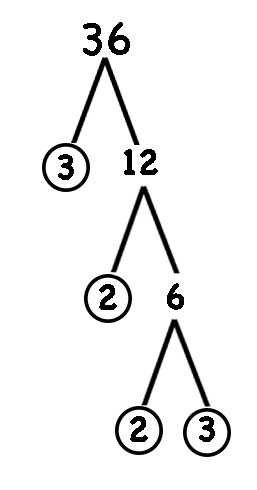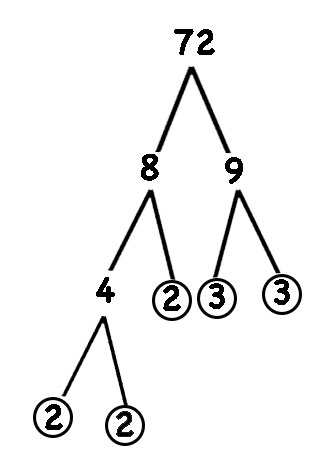Prime Factorization is the method of finding which set of prime numbers multiply together to make a number.
In a previous post, we talked about factorization, which is a method of finding the factors of a number but not necessarily the prime factors.
What is different with prime factorization is that we need to factorize the factors themselves, until we only have prime factors. A good way to do that is by using a factor tree.
For example, we can factorize 36 like this.

Four and nine are factors of 36. However, they are not prime numbers.

Numbers with more than two factors are called composite.
Since 4 and 9 are not prime numbers, we need to factorize them as well.

2 and 3 are both prime numbers, so we can write 36 as a product of these prime numbers.

We can start the factor tree with different factors of 36.

3 is a prime number so we only need to factorize 12. We also need to factorize 6.

Even though we started with different factors of 36, we ended up with the same prime factors. 2 x 2 x 3 x 3 = 36 Every whole number greater than 1 has one prime factorization.
What if the number is prime?
If the number is prime then its only prime factor will be itself since one is not considered a prime number.
Our example (36) is a small number. In the case that you have a greater number, you need to check if the number itself is a prime number.
To check if a number is prime you can do a divisibility check. That means to check if the number is divisible by 2, 3, 4, 5, 7, 11, 13. You can do this fast if you know the divisibility rules. Learn all about the divisibility rules here.
Here are some more examples.

8 and 9 are factors of 72. They are both composite numbers so we need to factorize them. 4 is a composite number as well so we need to factorize it. The prime factorization os 72 is 2 x 2 x 2 x 3 x 3

145 is divisible by 5, so I start with factors 5 and 29. Both of the factors are prime so the prime factorization of 145 is 5 x 29. I know 29 is a prime number because it is not divisible by 2, 3, 4, 5, 7, 9, 11, 12, or 13.

I know that 126 is divisible by 9 (divisibility rule of 9) so the factors I start with are 9 and 14. Since 9 and 14 are composite numbers I need to factorize them. The prime factorization of 126 is 3 x 3 x 2 x 7
Here is a worksheet to practice prime factorization.

